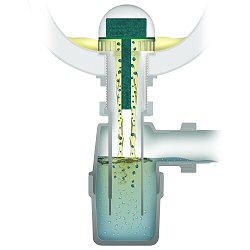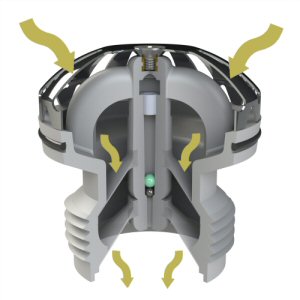|
There are 3 main types of waterless urinal namely, microbiological, barrier-fluid, and valve systems. All of these are effective if correctly maintained. Gentworks offers new urinal bowls with the barrier-fluid system from Uridan and Armitage Shanks Ardian. The GW6 valve cartridge can also be supplied with the Aridian bowl. For standard urinals, there are retrofit systems for converting urinals waterless, including the microbiological solution from Aquafree.
|
||
|
About Urinals and Water

A standard urinal that is not flushed regularly will soon stink and eventually block up. By contrast, a urinal that is flushed every 3 minutes (the typical time it takes to fill a cistern) is unlikely to smell or block. However, an unregulated urinal costs a fortune to run, is bad for the environment and contravenes water regulations. Most washrooms either employ a simple 'tap' or a more sophisticated flush controller to prevent such frequent flushing. Unfortunately, the reduction in the frequency and quantity of water passing through the waste pipes often leads to problems with odours and blockages. Reducing flush frequency without serious negative consequences is achievable, but it is necessary to find the right balance between reducing expenditure on water and increasing expenditure on maintenance. A rule of thumb is that a standard urinal should be flushed through within 20 minutes of use. This can be easily achieved with a flush controller incorporating a usage sensor . Urinals with flush controllers tend to block more frequently than those that are flushed every few minutes because uric acid salts have time to combine with the limescale in water to form a hard scale, particularly overnight and at weekends, when the flush controller is not activated by users.
How Waterless Urinals Avoid Blockages
A major advantage of all waterless urinals is that, to state the obvious, they do not use any water. If urinals are not flushed with water, there is no limescale entering the waste pipes and therefore nothing for the urine to combine with. Instead of hard scale, untreated and static urine eventually forms a soft sludge. In addition, hair and other debris inevitably enters the waste pipes and attract fats in urine, forming what is sometimes referred to as a 'hedgehog'. This can also cause blockages and foul odours, but is considerably easier to combat than the combination of urine and limescale.
Some waterless urinal systems, seek to avoid the problems of sludge build-up by trying to ensure the urine flows quickly through the urinal waste pipes to the main drain, often referred to as 'the stack'. In order to ensure 'free flow', the trap or u-bend usually found under the urinal is replaced with a right angled pipe so that urine and debris cannot collect. For this method to work well, waste pipework should be near to perfect in terms of the gradient (fall) towards the stack. Moreover, it is important to have clean pipes connected together without any ridges behind which urine and debris can collect. Having several right-angled connectors to reach the stack is not recommended. Gentworks recommends that valve-based systems are only fitted by those with prior experience of installing urinals.
Waterless urinals using the 'barrier-fluid method' (see below), often employ a cartridge that collects debris so that there is less chance of a blockage forming within the waste pipes.
The most popular waterless urinal systems use microbiology to treat urine as soon as it enters the waste pipes, breaking it down into constituent parts so that it is less likely to form sludge. However, whilst the microbes are very good at treating urine, they are not so successful at dealing with hair and other debris. So even in waterless systems, some form of manual flushing is often recommended.
|
||
|
How Waterless Urinals Avoid Odour Problems
There is no excuse for a urinal to smell, whether waterless or not. Most odours in washrooms are caused by inadequate cleaning regimes whereby odour causing bacteria are allowed to fester behind and underneath the urinal bowl. The inside of the urinal bowl needs to be cleaned regularly too. Many people are concerned that by not flushing the urinal bowl regularly, the bowls themselves become less hygienic and more likely to become smelly. In reality, limescale in flush water deposits an absorbent layer within which odour causing bacteria can develop. Waterless urinals, by contrast, have no such layer. Moreover, it is important to note that male urine is sterile, unless the individual has a kidney infection.
Another potential source of odours is the urinal waste outlets. With waterless urinals, there are broadly two approaches employed to prevent odours from the waste pipes reaching the washroom. Microbiological systems rely on the microbes breaking down the urine before it becomes malodorous, whilst barrier-fluid and valve systems seek to trap the foul air in the waste pipework.
|
||
 |
Microbiological Waterless Urinal Systems
Urine comes into contact with a block, often housed within a dome inserted into the urinal waste outlet. The block contains a number of active ingredients, including surfactants, but the most important of these is the microbial spores. Once taken down into the trap with the urine, the spores become active beneficial bacteria that 'feed' upon the urine and then multiply. By breaking down the urine into components, the bacteria from the block help prevent the build-up of sludge and crystals that are a major contributing cause to blockages. They also generate an environment hostile to the 'bad' bacteria that cause odours. Providing that some block is present and it contains the appropriate ingredients, then there is no requirement for "odour lock" mechanisms or valves. Appropriate cleaning chemicals must be used and simple but regular maintenance is required. Most importantly, the microbes cannot break down hair, grit and other debris that inevitably finds its way into the urinal trap and thence the waste runs. Therefore to push the debris down to the main drain before it can collect and cause a blockage, it is essential to pour some fluid down each urinal at regular intervals, usually once per week. This 'dosing' process is most effective when a mixture of warm water and an appropriate chemical is used. Click here for details on the Gentworks microbiological waterless systems.
|
 |
 |
Barrier-Fluid Waterless Urinal Systems
Urine and debris passes through an oil-based barrier fluid which forms the seal to prevent odours reaching the washroom . In some systems, the barrier fluid is contained within a replaceable cartridge that also captures debris that would otherwise fall into the waste pipes. Cartridges typically need to be replaced every 2 to 6 months, dependent on usage. The barrier fluid can be degraded, and need replacement, if incompatible cleaning chemicals are used. Otherwise, barrier systems work very well, although consumable costs may be high for busy washrooms. Barrier systems are used in several types of urinal bowls designed exclusively for waterless use, the most well known in the UK being Armitage Shanks Aridian. The latter model is quite popular in new builds. Another popular system is the Uridan, developed in Denmark, widely used across Europe and Australia, and increasingly popular in the UK.
|
 |
 |
One-Way Valve Waterless Urinal Systems
Urine passes through a one-way valve that closes once flow has stopped, preventing odours from being emitted into the washroom. The configuration of the waste pipes usually needs to be changed as they tend to work best with no traps or u-bends. Urine alone, rather than water or dosing chemical, has to carry away the hair and other debris to the main drain. The valve is the only barrier between the foul smelling drains and the washroom, therefore its effectiveness is crucial to success. There are many valve-based products available, some more reliable than others. To avoid odour problems, the valve has to close after use, having allowed any debris to flow through without becoming stuck. As an additional measure, some products use a microbiological block to treat the urine to help prevent build up in the waste pipes.
|
 |
|
Home
::
Waterless Urinal Technologies
|


